Freelance Writer Portfolio Guide: How to Create It Quickly & Easily
Working for yourself and creating your own schedule –who wouldn’t want that? Do you want to work in your PJs? Done! Are you a night owl and prefer working through the night? No problem, skip the early mornings! As a freelance writer, you’ll have all those privileges. But also the burden of finding new clients on your own. And for that, you’ll need some superb writing samples and a stunning portfolio website.
If you haven’t touched your writing portfolio in years, or need to build one from the ground up, this blog post is for you. We’ll help you get inspired with some real-life freelance writer portfolio examples and then give you some guidance on getting writing samples to fill up yours. We’ll show you everything important about how to make a portfolio as a freelance writer.
CONTENTS
- Freelance writer portfolio examples
- How to get writing samples for your freelancer portfolio
- How to create your freelance writer portfolio (once you have samples)
What is a freelance writer portfolio?
Your freelance writing portfolio is a collection of your best writing samples, organized in an easy-to-browse-through way.
That last part is very important, as you have to think about your potential clients when assembling your portfolio. They probably wouldn’t want to dig through a Dropbox folder with a bunch of documents dumped in, right?
If you want to convert those who are looking at your portfolio, you need to make it an easy and pleasant experience for them. The key to that is choosing the right format, which is a portfolio website –or a portfolio page on your writer website.
Do you really need a freelance writer portfolio?
When you get a client or two from referrals, you might start wondering, if having a portfolio is that important after all… But it is.
When it comes to your freelance writing career, you need to think “long term”. You might get a few referrals here and there, but is that a sustainable way of getting clients? What if you get recommended to someone, but they still want to see some of your previous work?
You should establish yourself as a professional through your online presence. Having a personal-yet-professional website that looks great and houses your very best pieces will do just that for you. It’ll be perfect when someone asks for your samples after a referral –and it’ll do wonders when someone new checks you out for the very first time.
Let’s see some freelance writer portfolio examples!
Before we get into the actual how-to of portfolio building, let’s check some examples from real-life writers! It’ll give you an idea of what a freelance writer portfolio should look like and hopefully get you excited to get started with building yours.
Tatiana Kanonerova
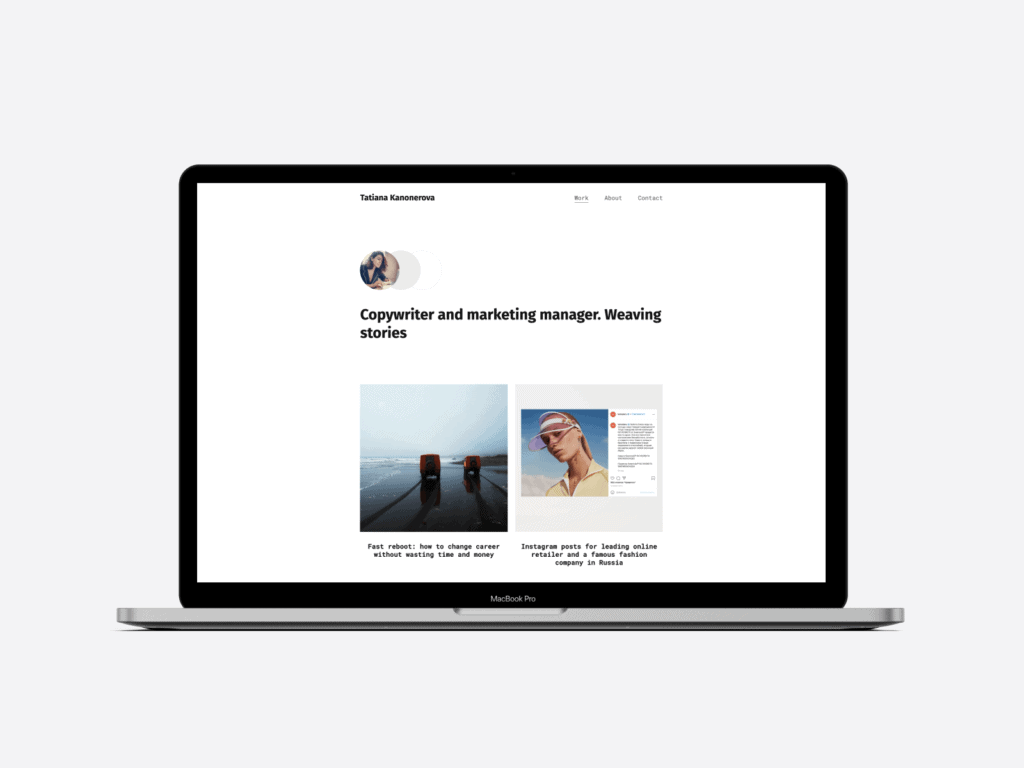
Emma Buckley
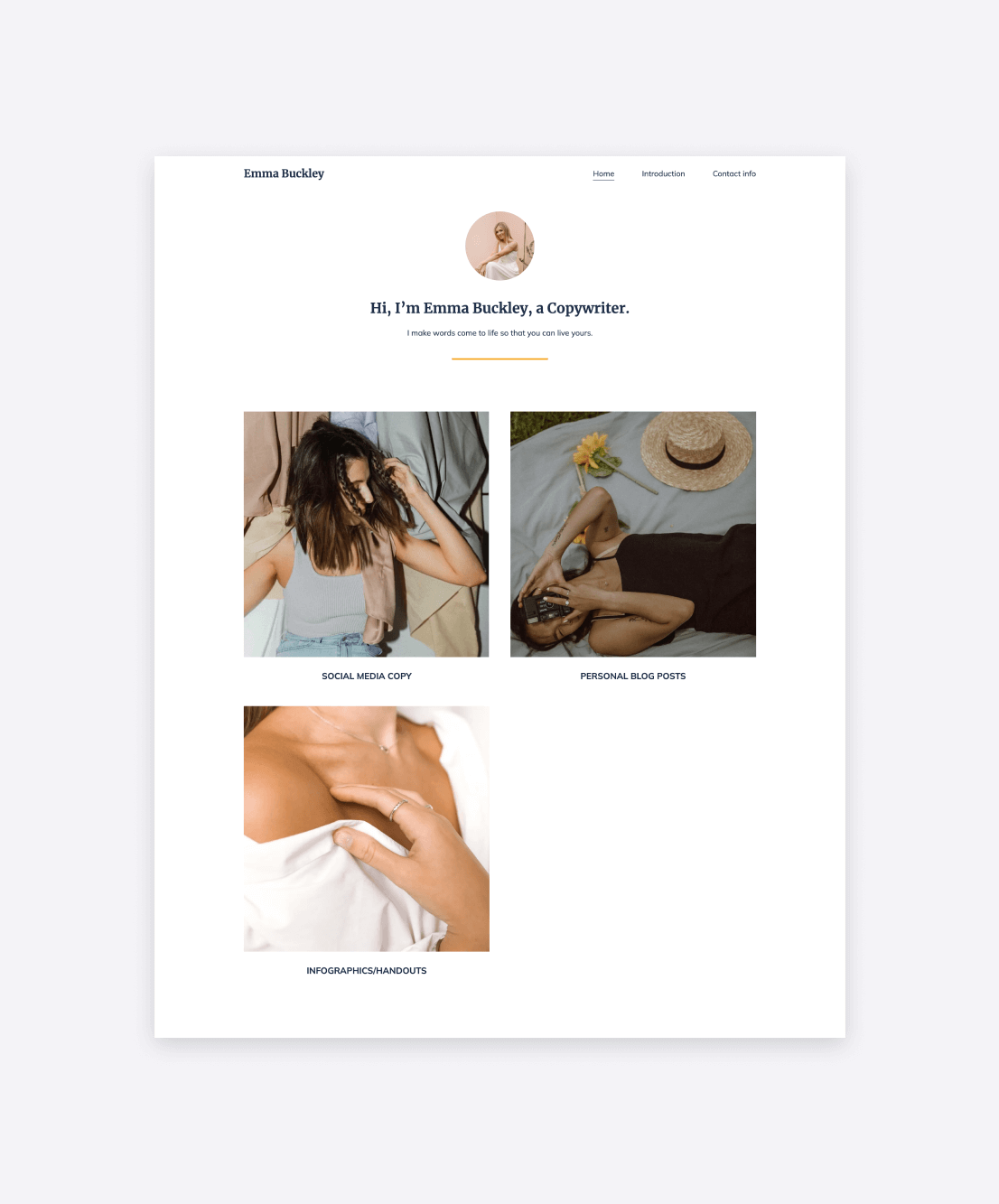
Emma created her portfolio with Copyfolio, using the "Letterpress" template.
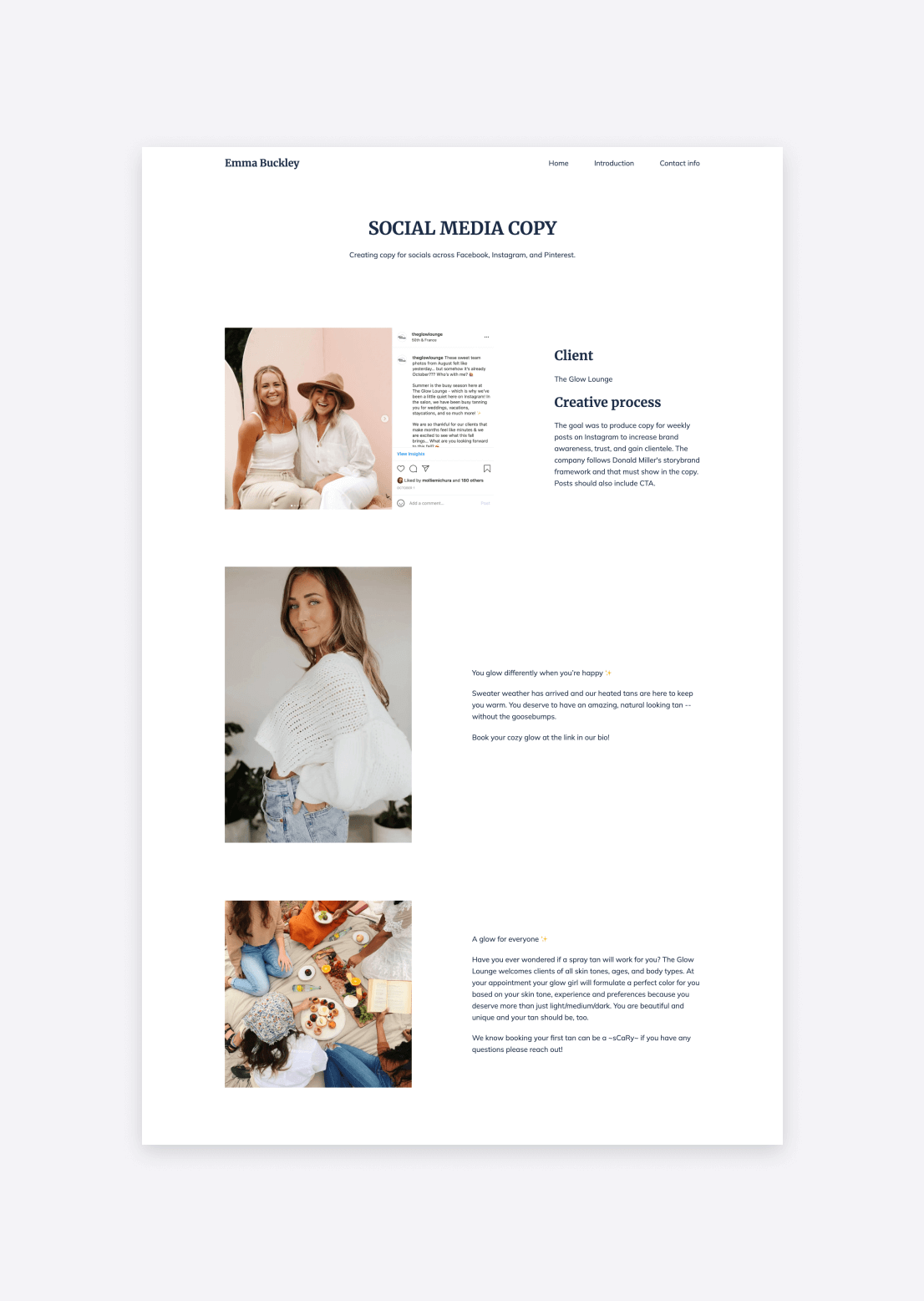
Megan Cornish
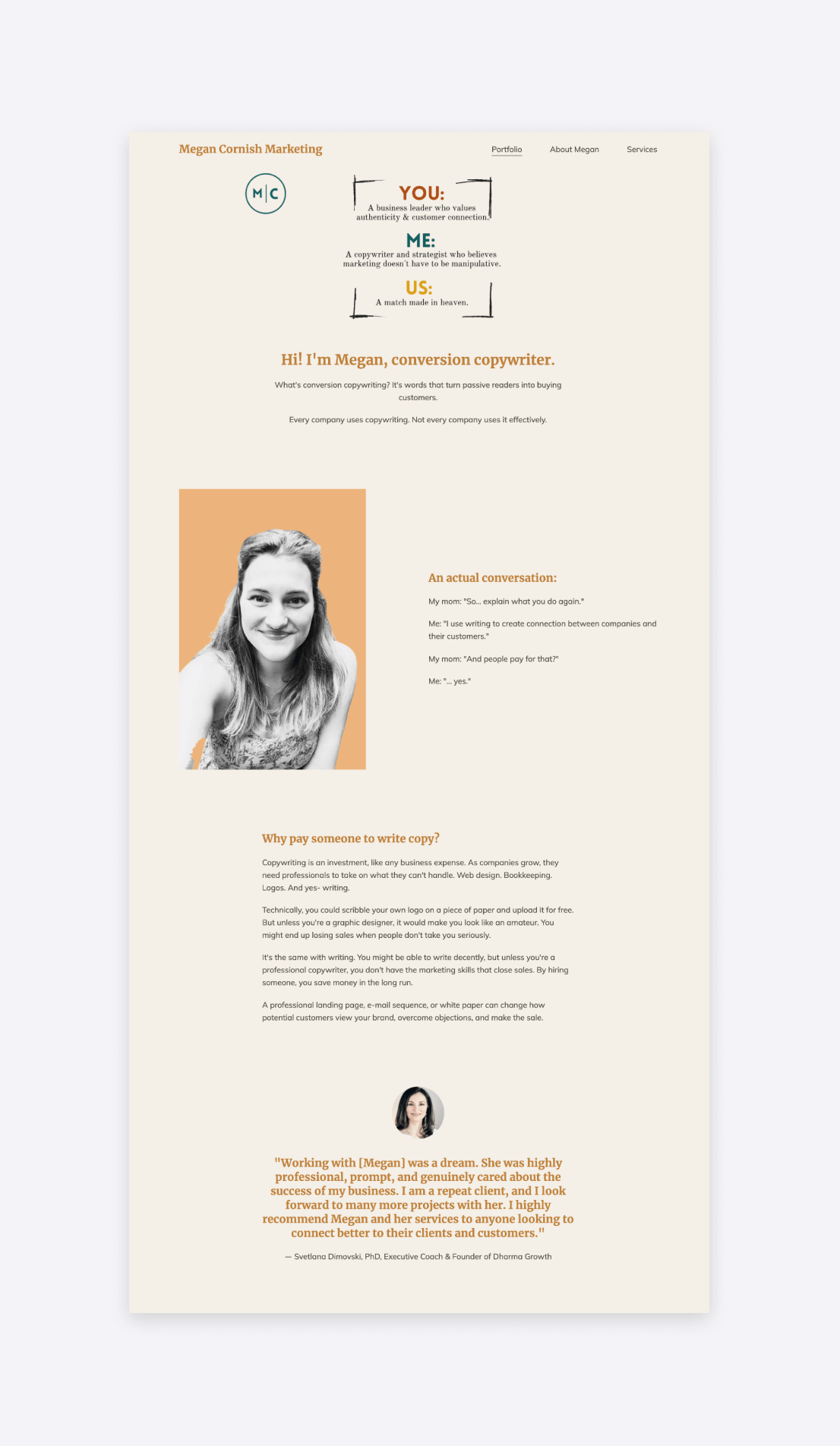
Megan's portfolio was made with Copyfolio. Give it a try and create yours today!
Halle Snavely
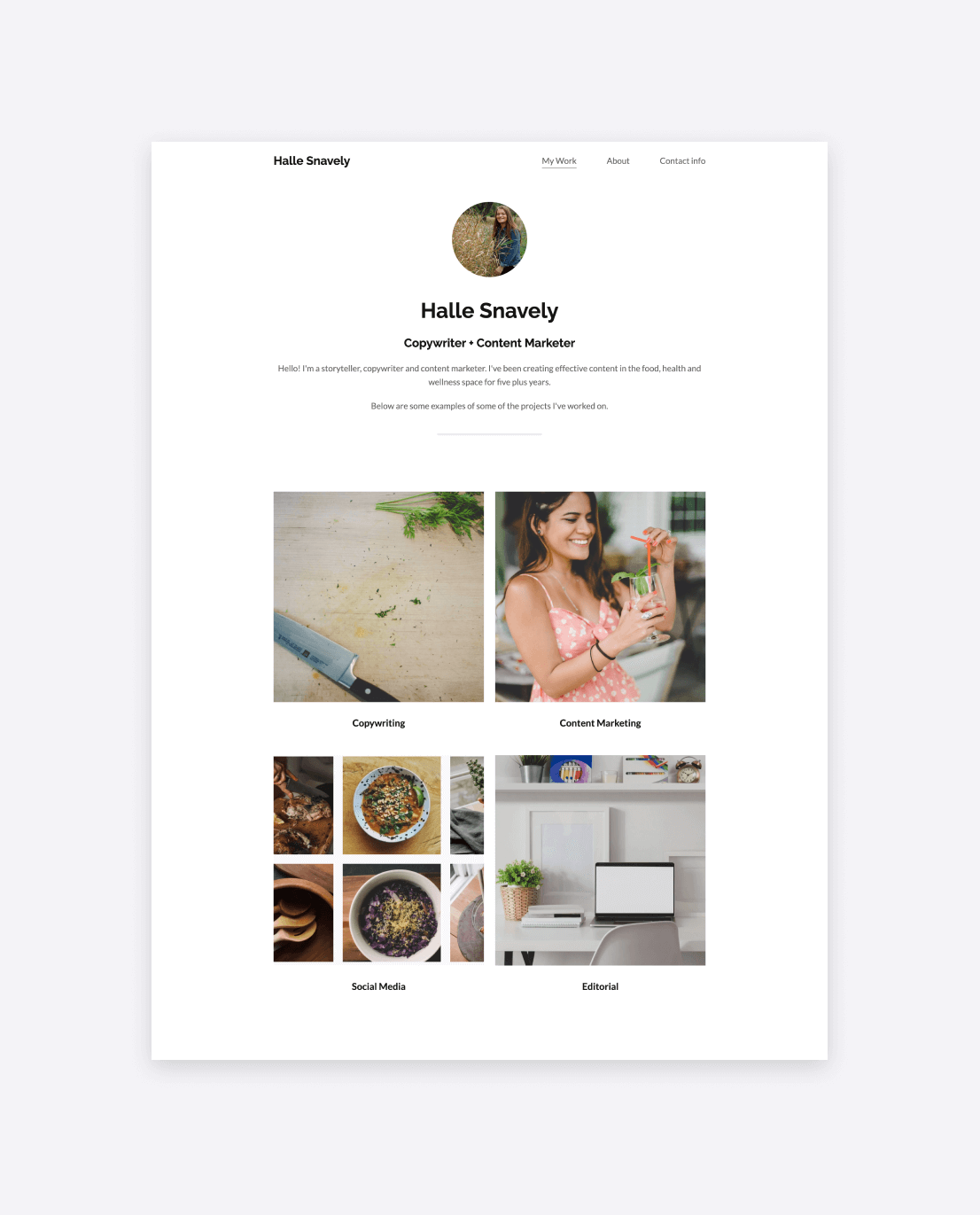
Halle used Copyfolio's "Letterpress" template and the "Ink" color palette to create her portfolio.
Olivia Craig
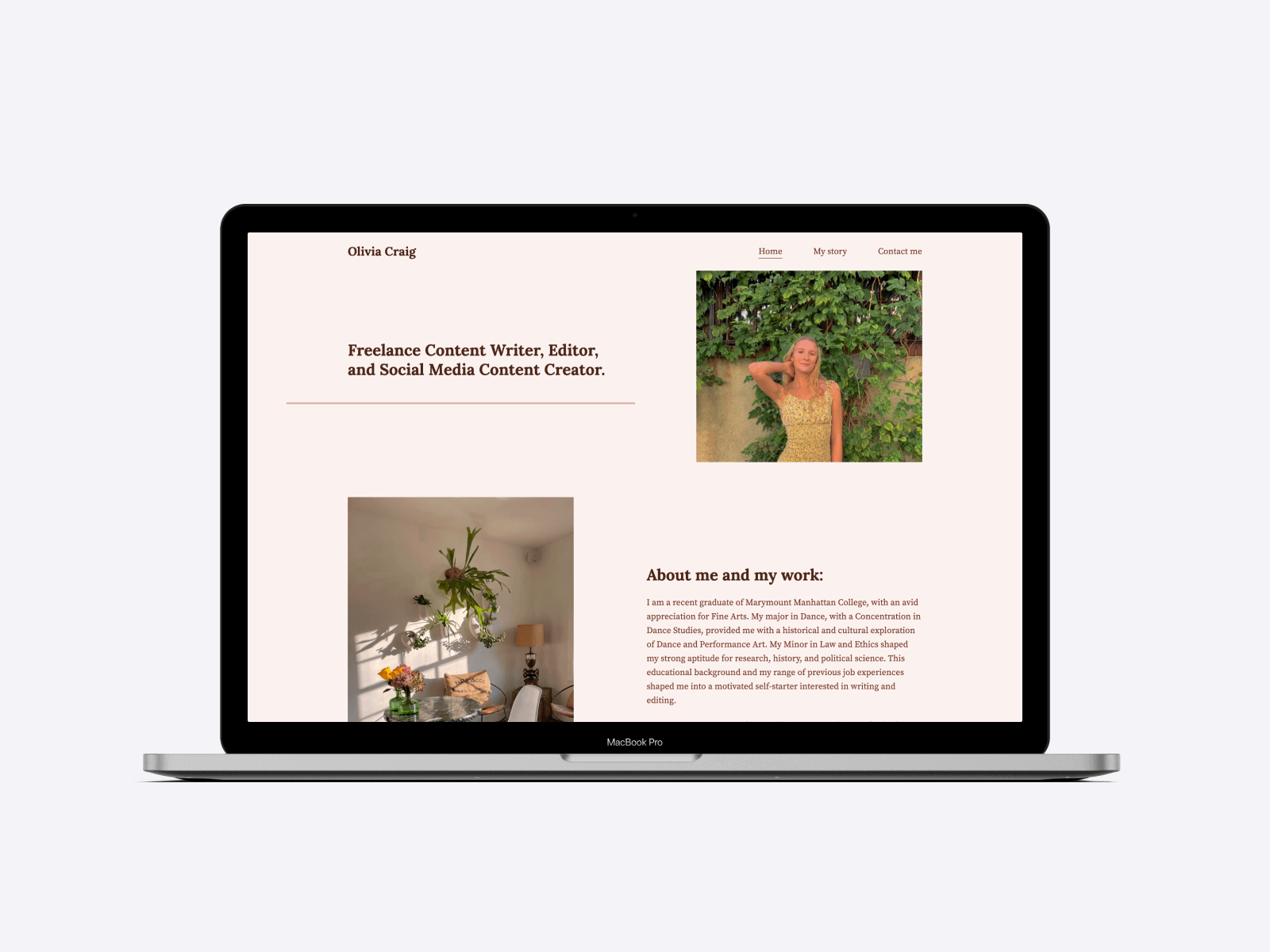
The portfolio website of Olivia Craig, created with the "Journal" template in Copyfolio.
Julie Tepe
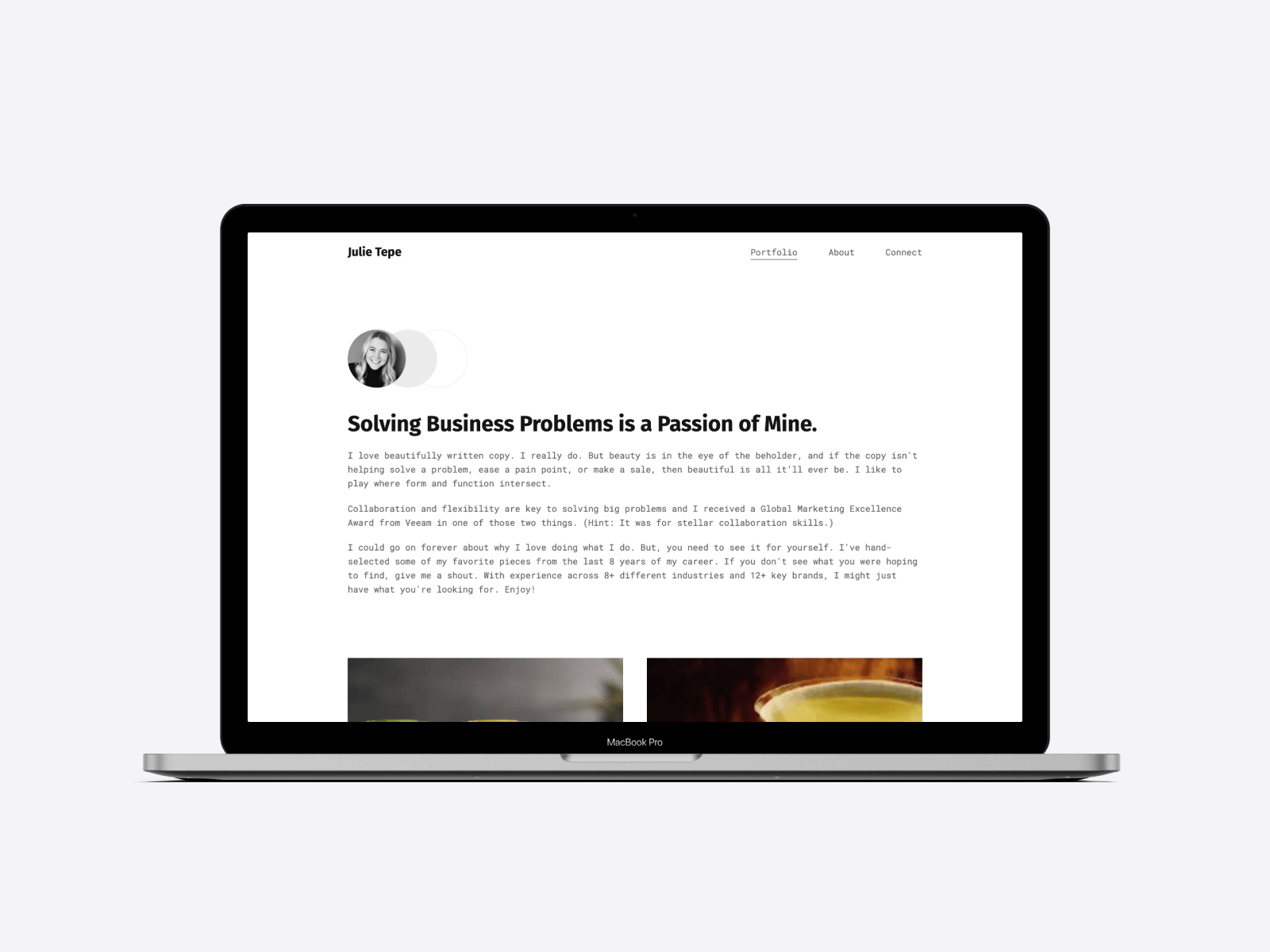
Julie used Copyfolio, with the "Typewriter" template to create her freelance writer portfolio.
The Copy Psychologist
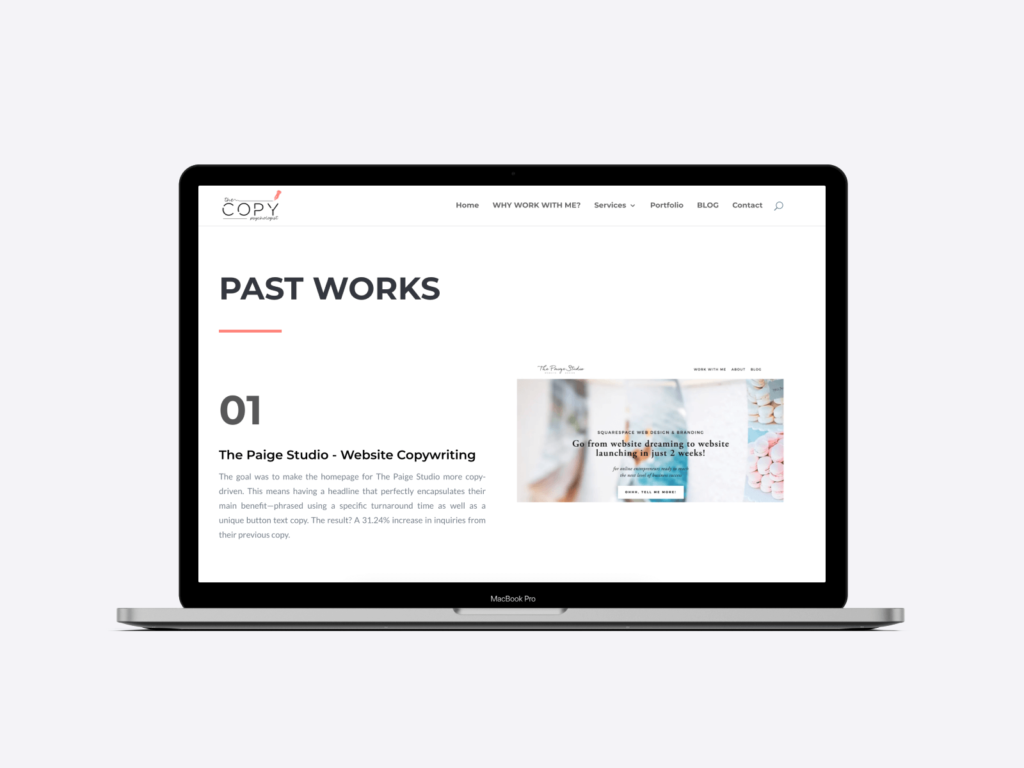
The portfolio (or "Past works") section on the Copy Psychologist's website
Alexa Peters
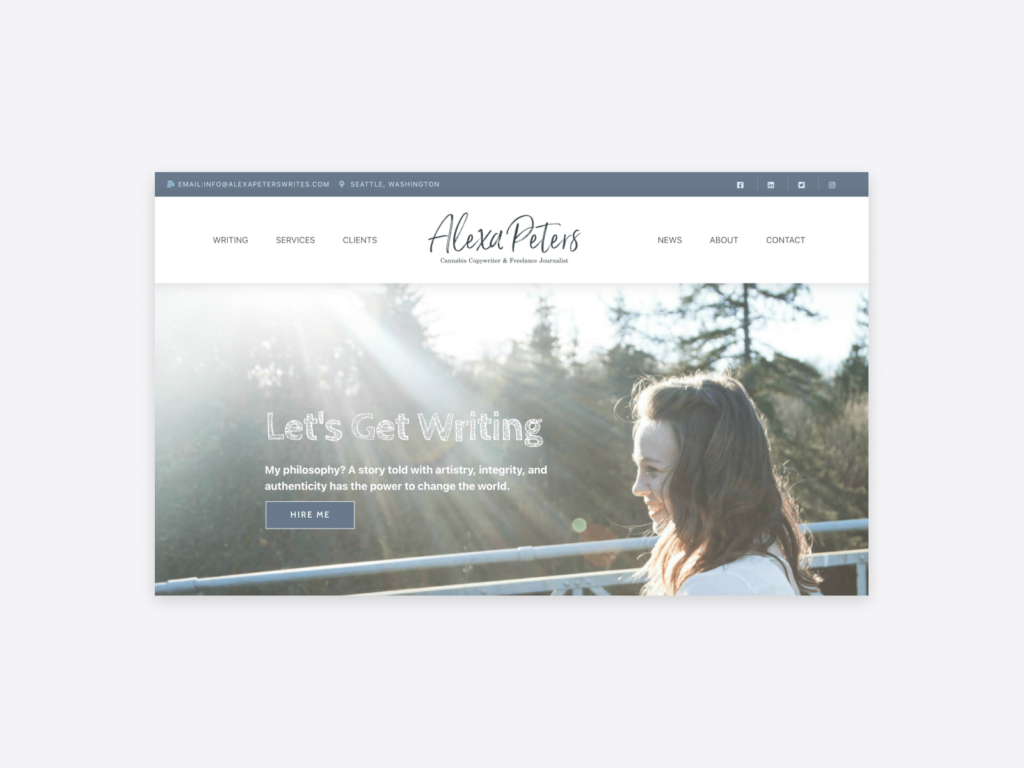
The freelance writer portfolio website of Alexa Peters copywriter
Elise Dopson
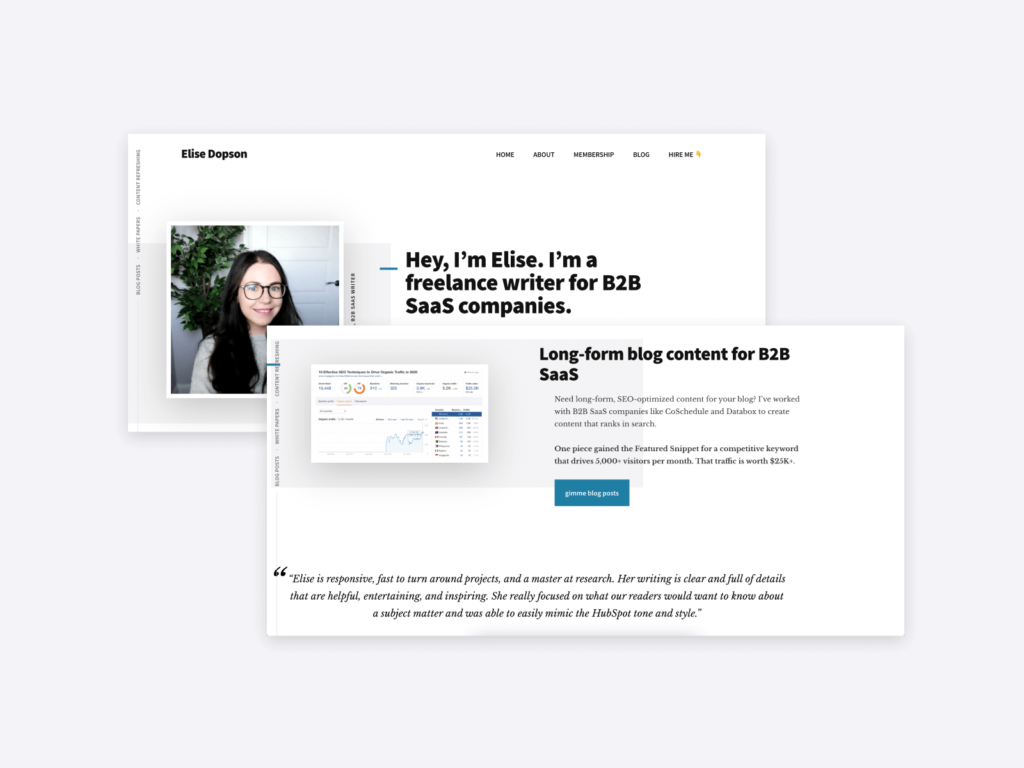
Screenshots from the website of freelance writer Elise Dobson
Kristi Hines
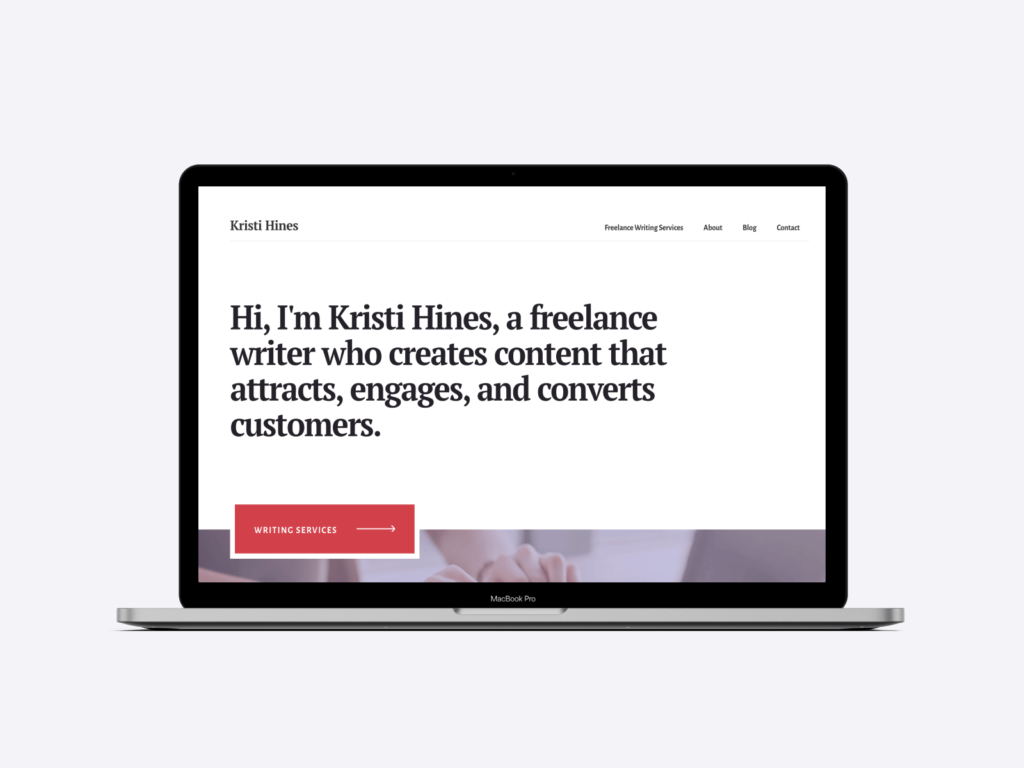
The homepage of Kristi Hines' freelance writer portfolio website
Cassidy Horton
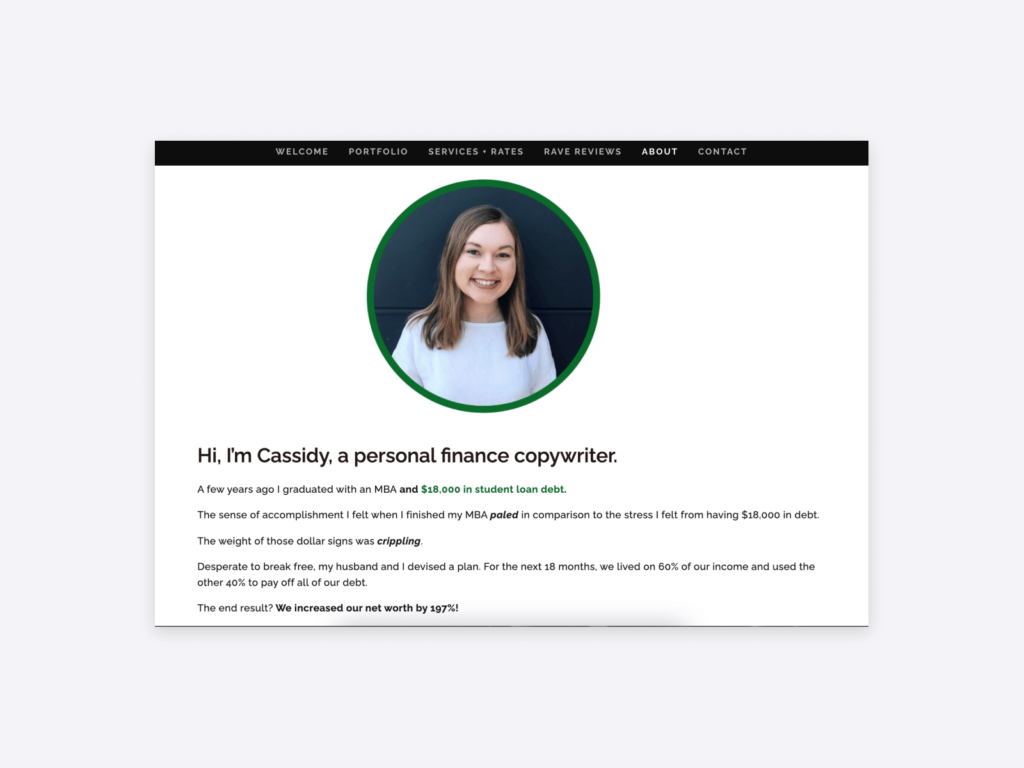
The about section of personal finance copywriter's Cassidy Horton's portfolio website
Tips for beginner freelance writers who need samples for their portfolio
The very first thing that you’ll need for a freelance writer portfolio is some writing samples. If you’re changing careers or just getting started in your professional life, you might not have any of these, and that’s okay.
In the next few sections, we’ll go over a few different ways to get and select some great samples for your portfolio.
Take a writing class to improve your skills and get samples
This is probably the most obvious of them all, but consider signing up for a writing class or workshop. It won’t only help you improve your writing skills, but you’ll likely get multiple writing assignments as part of the coursework. Implementing the feedback you get on them from your instructor, you can definitely use the improved versions in your portfolio later.
Find your writer specialization – based on your niche or preferred formats
One of the most important things when it comes to choosing or creating your writing samples is your specialization. This can mean two things. You can be specialized either in terms of the niche(s) you write for or the format of copy/content that you provide. So just to see an example, you could either be specialized in:
- The health and fitness niche, writing a variety of formats in those topics, or
- Email marketing, writing well-converting email campaigns for a variety of niches
Whichever kind you choose is fine, but to be able to better market yourself as a freelance writer, you should commit to one. And once you figure that out, make sure you write or choose your writing samples accordingly.
When someone checks out your portfolio, they should be able to tell what you’re specialized in right at the first glance.
A quick tip: if you’re not sure if you managed to do that, ask somebody to look at your portfolio. Ask them to tell you what kind of writer they think you are. Ask them what kind of project they’d hire you for. If their answer is not what you want to hear, you can always tweak your site and samples a little more.
Write spec ads, try guest posting or help your friends out
Once you feel like your skills are polished enough and you decided on the direction you want to take with your writing career, it’s time to sit down and actually write some samples. Here are a few things you can try.
If you’ll be specialized in copywriting, you can create spec ads in collaboration with a graphic designer. Spec ads are basically fake ads that students of advertising programs often make. You can think of a concept yourself or you can figure it out together –then you write the copy and your partner creates the designs. You can both display the finished ad in your portfolio, just make sure to always credit your partner for their work.
If you want to focus on writing longer content, you can try guest posting. What is guest posting or guest blogging? It’s when an article you wrote gets published on a blog that’s not your own. You contact the editors of a blog with a pitch about your chosen topic or send a whole outline –it all depends on what their guidelines tell you to do. It’s a great opportunity, as it gives you credibility, a variety of samples to showcase, and even links back to your own website.
Another thing you can always try is offering your services to those around you: your friends and family members. You can do that for free in the early days, when you want to build up your freelance writer portfolio, or for a symbolic amount. This way you get assignments and honest feedback on your work without the pressure of a higher-paying gig –and you can help your loved ones and their businesses at the same time.
And if all else fails, you can always just make up projects and assignments and write the copy for those. As long as your writing is good and you can demonstrate your problem solving and creative process, nobody will care if it was an actual paying gig or not. Feel free to create more samples for practice than what you’ll actually need –you can always filter them to add only the very best ones to your portfolio.
How to create your freelance writer portfolio (once you have writing samples)
Having great writing samples is important, but they won’t do anything for you if they’re not presented in an optimal way. So in this section, we’re going to give you practical tips for building a portfolio, so that it’s clean and organized and will convert your visitors into paying customers.
Limit the number of your writing samples to save your readers’ time
As a writer, you already know that you always have to think about your reader when you’re creating something. The same goes for your freelance writer portfolio. Your potential clients won’t want to spend hours looking at your portfolio –they simply don’t have the time for that.
So you need to make sure that you can convince them with your site and writing samples in about 15 minutes. That’s the maximum amount of time they’ll probably spend on your portfolio website.
An easy way to make sure that they can finish reading in time is by limiting the number of writing samples you include in your portfolio. We recommend adding at least 4, but no more than 6-8 projects.
Use good-looking, eye-catching thumbnails for your writing pieces
Having your projects up on your site is one thing. But getting your visitors to click through is another. To increase the chances of them checking out your projects, choose eye-catching thumbnail images for each of them.
A quick tip: take a look at how all of the thumbnail images look together. Do they have the same color palette? Are they all logos or all mockups? Make sure they are of the same type and have similar colors for a cohesive overall look.
Treat describing your projects as writing mini case studies
Sure, if you just drop a link to something you wrote before, they could go and read the whole thing to try to assess your writing skills. But back to our earlier point, your potential clients probably won’t have the time to do that. And it won’t answer all their questions about your expertise either.
Instead, you should treat describing your projects as writing mini case studies. Of course, you can still link out to the finished piece –but you should give your readers some background information on how it came to be. You should write about:
- how you got the assignment and what the initial task you got was
- your creative process of coming up with ideas for the project
- any challenges you faced while working on it and how you overcame them
You should also show the end result in the form of an image. If it’s something that’s live somewhere online right now, take a screenshot of it! You never know when they might take the content or the whole site down, or when they decide to edit your original work. So it’s best to have visual proof of what you did to make sure you don’t lose any of your references because of events like that.
A quick tip: use a portfolio builder like Copyfolio, which helps you write your case studies. Having the sections you'll need set up, with the right mockups and guiding questions will make the writing process ten times faster.
Establish your credibility with testimonials and recommendations
“Anybody can say anything about themselves on the internet.”
Isn’t that so true these days? Even though your writing samples and case studies should be enough proof of your skills and experience... There’s one more thing that can boost your credibility in the eyes of potential clients: testimonials.
Especially if they’re paired with the names, photos, and even links of their authors, testimonials and recommendations can give you a proof of trustworthiness and expertise. And a huge nudge for your visitors to get in touch with you.
Use a call-to-action to guide your visitors to contact you
One thing you should know about people visiting a website (whether it’s a portfolio or just a regular site) is that they need clear instructions on what to do there, otherwise they’ll explore a little bit, then simply click off. These instructions are called CTAs or call-to-actions.
This can be telling them to check out your projects, read your about me page or get in touch with you. CTAs can be displayed as buttons or even just simple texts or links.
A quick tip: Make sure you always have only one CTA per page. Having multiple all on the same page will distract your visitors and decrease the chance of them converting. You can have different ones throughout your site –but only one on each page.
Make sure your portfolio is responsive and looks good on all devices
Did you know that about half of most websites’ traffic (if not more) comes from mobile devices? To cater to those who would want to check out your freelance writer portfolio from their phone, you need to make sure that your site is responsive.
So you need to choose a platform that makes that not only possible but also easy for you. And even when it does, you should still check how your site looks on a phone before sending out the links to it. You should pay attention to how your images are displayed and whether you can see all of their details clearly –and how your headlines fit (or break) throughout the site.
Choose a fast and easy-to-use website builder to create your freelance writer portfolio
If you want to make sure you can follow all of the tips above, you need to choose a suitable website builder. Here are the boxes it’ll have to check, to save you time and guarantee a great website building experience. The website builder you choose should...
- be a “what you see is what you get” type of editor, where you can see in real-time how your live website is going to look, while you’re editing it. It’ll save you lots of time going back and forth between the editor and the live site view.
- have a fast and reactive editor. If you have to wait minutes at times for the editor to load and you’re looking at the loading screens more than at your actual website… that’s not the one for you.
- be very easy to use, not requiring manuals and tutorials. It might be a cliché, but time is money –and time spent figuring out how to make your website editor work is not time well spent. Always look for intuitive design.
- give you flexibility with sections. You should be able to customize your pages by switching sections around, adding text, images, and more wherever you want.
- have unique features that save you time. Like providing you predesigned palettes to change the colors of your site without having to figure out what colors look good together and fit your site at the same time.
- help you beyond just providing a platform to build your site. You’ll make the best choice if you choose a website builder that will stay with you the whole time, guiding and teaching you to make sure your website will be amazing. With tooltips, blog posts, and a great team and community behind it all.
Sounds like a long list of expectations? Don’t worry, Copyfolio checks all these boxes and more. It’s not only super fast and easy to use, teaching you how to build a freelance writer portfolio along the way. It’s also specialized for writers, which means it’s catered for your needs specifically.
Copyfolio makes building a website quick and easy by giving you design presets to change the whole look and feel of your website with just a few clicks. It also takes you through the steps of writing an ideal case study to describe your products and convert visitors into clients. Need even more tips and inspiration? Head over to the blog or LinkedIn profile!
Sign up now and create a stunning freelance writer portfolio in no time!





